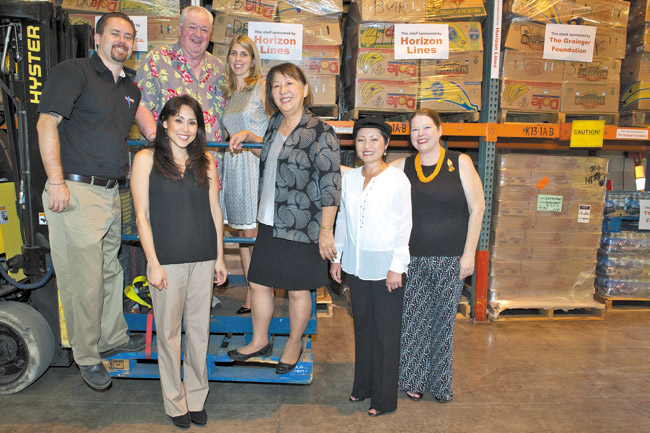Filling Foodbank Racks

(from left) Grainger Foundation operations manager Jeremy Heen, Hawaii Foodbank president and CEO Dick Grimm, Cutter management CO audit and tax management Kim Fujikawa and vice president Heather Cutter, Hawaii Foodbank board chairwoman Linda Chu Takeyama, Horizon Lines customer service and documentation manager Kelly Murata, and Hawaii Foodbank vice president and COO Polly Kauahi
With need growing, Hawaii Foodbank is asking businesses to contribute to its first-time Rack-A-Thon, and some companies already have stepped in to help
If the racks at Hawaii Foodbank could talk, what would they say? Certainly there would be some interesting stories and observations about what’s stored on its shelves.
On good days, the racks would express jubilation at 1,122 pallets in the 23,668-square-foot warehouse being fully stocked with goods for those in need.
But they would lament those times when supplies are woefully low, like now, and empty boxes sit on the shelves. Auwe.
The mighty racks regularly serve agency representatives who are at the food bank to gather provisions for needy clients. These grocery shoppers are compassionate souls who serve as lifelines to those living from hand to mouth.
During September, Hunger Action Month, the racks are telling a different story. The warehouse shelves are the focus of a unique Hawaii Foodbank initiative in fundraising.
As local charities experience funding cutbacks, an over-subscribed pool of donors and challenging economic conditions, they are facing harsh realities.
It just can’t be business as usual. It’s time for thinking outside the box.
“Food banking has changed dramatically in the last 10 years,” affirms Polly Kauahi, Hawaii Foodbank vice president and chief operating officer. “Ever-rising food prices have resulted in an increased demand for our services, while also decreasing the amount of goods that individuals and companies are able to donate.”
Thus fundraising becomes the bane of existence.
But just how many gala banquets, golf tournaments and celebrity chef events can a charity sponsor without diluting funds for its main mission? Not to discount the value of such events, but staging them is expensive.
Hawaii Foodbank’s innovative response is a Rack-A-Thon, which is being launched this month. Donors have the opportunity to sponsor a total of 28 racks, stacks and shelves at the food bank’s Mapunapuna warehouse.
Sponsors at four levels, ranging from $2,500 to $25,000, are recognized by signs on designated racks, stacks or shelves. Their logos will be featured in the Sept. 10 Hunger Action Month section of Honolulu Star-Advertiser and special mahalo page in MidWeek.
There also are inclusions in Hawaii Foodbank’s e-newsletter, on its Web page and on social media posts.
“Every dollar of a Rack-A-Thon sponsorship goes into purchasing food for distribution in the community,” explains Kauahi. “Private donors, foundations and corporations are able to have a concrete vision of what their contributions provide.”
“It gives donors a chance to engage in a way that is more immediate and intimate than our more traditional special events,” she adds, noting a $250,000 goal.
Pay attention, market-minded donors who want brand alliance with a good cause. Here’s a program with accountability and transparency to align with tax-deductible charitable dollars.
According to Tasha Major, Hawaii Foodbank events coordinator, more than a dozen sponsors responded immediately to Rack-A-Thon solicitations. A shipping line, a car dealership and foundations are among the charter sponsors.
The campaign underscores the importance of keeping racks replenished and stocked to meet community needs.
When community food drives and bulk donations fall short, there is a gap in service that must be met by purchasing food.
Statistics tell the story. According to Kauahi, in 2004 the food bank purchased 1 percent of the food distributed.
“For the last several years, we have had to purchase more than 20 percent of the food in order to keep up with demand,” she explains. “In 2015, we expect to spend more than $900,000 on buying and shipping food.”
Funds from Rack-A-Thon sponsorships are earmarked exclusively for such purchases.
Lori Kaya, Hawaii Foodbank grants and communications manager, adds to the sense of urgency, noting, “We currently have 14 days of food, or 711,361 pounds. Our inventory is especially low during the months of September through October.”
It’s a simple lesson.
When the cupboards are bare, food and hope for more than 123,000 households encompassing 287,000 islanders — one in five residents — are affected.
Children and kupuna (seniors) are especially vulnerable, representing 35 percent of needy households. Twenty-two percent are military families.
Hawaii Foodbank is the only agency on Oahu that collects, warehouses and distributes mass quantities of perishable and nonperishable food to help feed the hungry. Donated and purchased foods are distributed to more than 200 member agencies on Oahu and Kauai.
Last year the food bank distributed more than 13.4 million pounds of food, including 3.1 million pounds of fresh produce to those needing emergency food assistance.
So if your company or organization wants to participate in the Rack-A-Thon, we’d recommend acting quickly before those clever Hawaii Foodbank folks designate other parts of its warehouse for sponsorships including doors, windows, forklifts and trucks.
For online donations to Hawaii Foodbank Rack-A-Thon, visit hawaiifoodbank.org.





